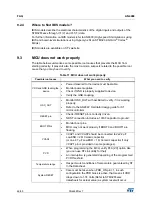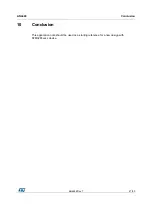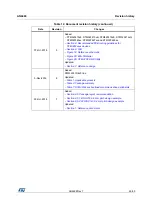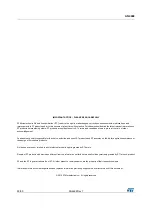
AN4488 Rev 7
39/50
AN4488
Recommended PCB routing guidelines for STM32F4xxxx devices
49
8.4.2
Flexible memory controller (FMC) interface
Interface connectivity
The FMC controller and in particular SDRAM memory controller which has many signals,
most of them have a similar functionality and work together. The controller I/O signals could
be split in four groups as follow:
•
An address group which consists of row/column address and bank address.
•
A command group which includes the row address strobe (NRAS), the column address
strobe (NCAS), and the write enable (SDWE).
•
A control group which includes a chip select bank1 and bank2 (SDNE0/1), a clock
enable bank1 and bank2 (SDCKE0/1), and an output byte mask for the write access
(DQM).
•
A data group/lane which contains 8 signals (a): the eight D (D7–D0) and the data mask
(DQM).
Note:
It depends of the used memory: SDRAM with x8 bus widths have only one data group, while
x16 and x32 bus-width SDRAM have two and four lanes, respectively.
Interface signal layout guidelines:
•
Reference the plane using GND or PWR (if PWR, add 10nf stitching cap between PWR
and GND
•
Trace the impedance: 50
Ω
± 10%
•
The maximum trace length should be below 120mm. If the signal trace exceeds this
trace-length/speed criterion, then a termination should be used.
•
Reduce the crosstalk, place data tracks on the different layers from the address and
control lanes, if possible. Ho wever, when the data and address/control tracks coexist
on the same layer they must be isolated from each other by at least 5 mm.
•
Match the trace lengths for the data group within ± 10 mm of each other to diminish the
skew. Serpentine traces (back and forth traces in an “S” pattern to increase trace
length) can be used to match the lengths.
•
Placing the clock (SDCLK) signal on an internal layer, minimizes the noise (EMI).
•
Route the clock signal at least 3x of the trace away from others signals. Use as less
vias as possible to avoid impedance change and reflection. Avoid using serpentine
routing.
•
Match the clock traces to the data /address group traces within ±10mm.
•
Match the clock traces to each signal trace in the address and command groups to
within ±10mm (with maximum of <= 20mm).
•
Trace the capacitances:
–
At 3.3 V keep the trace within 20 pF with overall capacitive loading (including Data,
Address, SDCLK and Control) no more than 30pF.
–
At 1.8 V keep the trace within 15 pF with overall capacitive loading (including Data,
Address, SDCLK and Control) no more than 20pF.
8.4.3
Quadrature serial parallel interface (Quad SPI)
Interface connectivity
The QUADSPI is a specialized communication interface targeting single, dual or Quad SPI












































